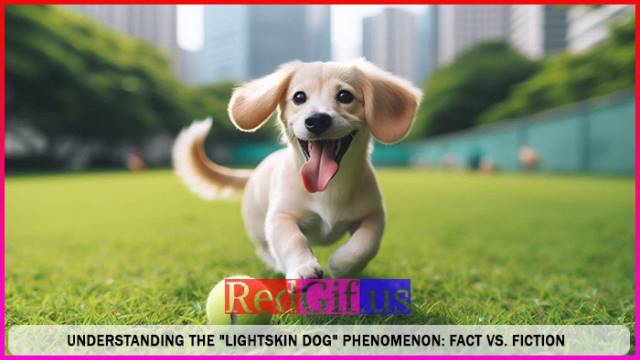Understanding the “Lightskin Dog” Phenomenon: Fact vs. Fiction

What’s the Deal with ‘Lightskin Dog’
The internet is filled with discussions, memes and viral content about ‘lightskin dog’. But what does it even mean? Is it just a meme or is there more to this? Some use the term humorously, others are genuinely wondering if there’s a specific breed or genetic trait behind these ‘lightskin dogs’.
Let’s clear up the confusion. ‘Lightskin dog’ generally means dogs with lighter coats, often cream, white or pale golden. It’s not a breed but a description that can apply to multiple breeds of dogs. The term has gone viral online and created a mix of curiosity and misinformation. So what’s the real story?
The Myths and What You Need to Know
There’s a lot of noise out there and it’s easy to get lost in the sea of opinions, memes and myths. Some people think ‘lightskin dog’ are a rare breed or that their light coat gives them certain personality traits. Others worry about health issues or special care needs for these dogs. This confusion can lead to myths and potentially influence dog owners and those thinking of getting a dog.
In reality coat color in dogs is determined by a combination of genetics, breed characteristics and sometimes environmental factors. There’s no scientific basis for the idea that dogs with lighter coats behave differently to their darker coated counterparts. But that doesn’t mean the topic isn’t interesting or that these dogs don’t have specific needs.
The Facts, the Science, and the Case Studies
Let’s get into the science of coat color in dogs, with real-world case studies and expert advice.
1. Light Coats Genetics
Coat color in dogs is controlled by two pigments: eumelanin (black or brown) and pheomelanin (yellow or red). Multiple genes control the distribution and concentration of these pigments and how they interact to produce all the colors we see in dogs today.
For example the MC1R gene controls the production of eumelanin and the ASIP gene controls the distribution of pigment across the coat. A dog with a mutation in the MC1R gene might have a lighter coat and produce colors like cream, white or pale gold. This genetic variability is why you can find “lightskin dog” in many breeds.
2. Breeds that can produce Light Coats
Any breed can technically have a light coated dog but some breeds are more likely to produce lighter colors. Breeds like the Golden Retriever, Labrador Retriever (especially the Yellow Lab), Poodles and Maltese are known for their light colored coats.
Case Study: Golden Retrievers
Golden Retrievers are a breed where light coats are common. They’re often praised for their golden to cream coats. Interestingly, the popularity of light coated Golden Retrievers has increased over the years especially in the UK where light is preferred. A study on Golden Retrievers found that light coated dogs are more common in breeding lines that prioritize appearance for show standards rather than working lines where coat color is less important.
Case Study: Labrador Retrievers
Labrador Retrievers especially the Yellow Lab are another breed where light coats are common. The Yellow Lab’s coat color can range from almost white to fox red. A study in the journal Animal Genetics found that the wide range of coat colors in Labradors is due to variations in the E and B loci genes which control the production of eumelanin and pheomelanin.
3. Care Considerations for Light-Coated Dogs
While coat color doesn’t determine behavior or health, light coated dogs do have needs. For example, lighter coats show dirt and stains more easily so you need to bathe more often. And light skinned dogs (those with pink or pale skin under their fur) are more prone to sunburn especially in areas with less fur coverage like the nose or ears.
Case Study: Maltese Grooming Needs
Maltese dogs with their long flowing white coats need to be groomed regularly to look their best. A case study from a grooming salon in New York showed the challenges owners face in keeping a Maltese’s coat. Brushing regularly to prevent matting and many owners opt for professional grooming to manage the long fur.
Case Study: Sun Protection for Light Skinned Dogs
A veterinary case study from Australia where sun exposure is a big concern looked into the risks of UV damage in light skinned dogs. The study found that dogs with pale skin especially those with light colored noses or ears are more prone to sunburn. The researchers recommended applying pet safe sunscreen on exposed areas during prolonged outdoor activities.
FAQs
Are “lightskin dog” a breed?
No, “lightskin dog” is not a breed. It’s a term that refers to dogs with lighter coat colors which can be found in various breeds like Golden Retrievers, Yellow Labradors and Maltese.
Do light coated dogs need special care?
Yes, light coated dogs need more frequent grooming to keep their coat clean and may be more prone to sunburn especially if they have pale skin under their fur. Brush regularly and use pet safe sunscreen.
Are there health issues with light coat colors in dogs?
No, light coat color itself doesn’t determine health issues. But light skinned dogs may be more sensitive to sun. Always consult your vet for advice specific to your dog.
Conclusion: The Reality of ‘Lightskin Dogs’
The obsession with “lightskin dogs” may have started online but it’s based on real genetic science and breed characteristics. Whether you like light coated dogs for their looks or just want to know more about what makes them special, you need to know the facts.
These dogs are beautiful but they need the same love, care and attention as any other dog. Their light coats may present some special grooming needs or sun protection requirements but with the right care they can thrive just as well as any other dog. So if you’re thinking of adding a “lightskin dog” to your family, rest assured with a little knowledge and preparation you’ll be ready to give them a happy healthy life.


